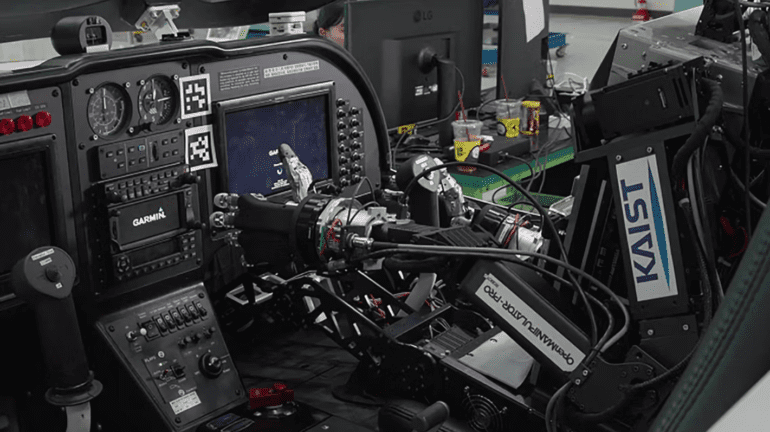TL;DR:
- Researchers at KAIST unveil Pibot, an AI-powered humanoid robot capable of flying aircraft.
- Pibot can handle all flight controls, communicate with Air Traffic Controllers, and ensure safe flying in challenging conditions.
- It differs from autopilot and unmanned vehicles by emulating human decision-making and memorizing extensive flight data.
- Pibot’s precision and emotion-free operation enhance aviation safety.
- Plans are in motion for Pibot to pilot a light aircraft soon.
Main AI News:
In a remarkable stride towards the future of aviation, a distinguished team of researchers hailing from the prestigious Korea Advanced Institute of Science & Technology (KAIST) has unveiled Pibot, a groundbreaking humanoid robot with the remarkable ability to pilot aircraft. This groundbreaking development ushers in a new era of aviation, as Pibot showcases its prowess in effortlessly maneuvering an airplane from the moment it takes off to the precise moment it touches down – all without any substantial alterations to the conventional cockpit design.
Pibot’s Astonishing Capabilities Pibot’s capabilities extend far beyond conventional robotics. This marvel of technology possesses an uncanny knack for selecting, managing, and manipulating all aircraft controls within the cockpit. Guided by its remarkably human-like hands, Pibot demonstrates astonishing dexterity, allowing it to expertly grasp and manipulate cockpit controls, including the critical task of adjusting aircraft thrust.
The Pioneering Role of Artificial Intelligence (AI) This astounding feat of engineering is a testament to the integration of Artificial Intelligence (AI) into modern cockpit systems. Collaborating with distinguished KAIST Professors, the Korean research team has brought to life a 5-foot-3-inch (160 cm) tall humanoid, weighing approximately 143 lbs (65 kg), known as Pibot. This remarkable machine comfortably takes its place in the aircraft cockpit, efficiently overseeing and executing every single control required for flight, including maintaining a stable altitude.
Precision in the Skies The developers behind Pibot proudly assert that this AI-based marvel excels in handling controls with precision, even under the most demanding flight conditions. During flights, Pibot maintains seamless communication with Air Traffic Controllers (ATC), swiftly responding to commands and ensuring the utmost safety, especially in the vicinity of airports. Regardless of turbulence or emergency scenarios, Pibot retains control, guaranteeing the safe passage of the aircraft.
Dr. David Hyunchul Shim, a distinguished figure among the researchers, elaborates on Pibot’s capabilities, stating, “Pibot’s human form may not be super efficient, but they designed it to be a humanoid form since everything in the cockpit is built for humans. It uses high-precision technology to control its arms and fingers to operate an aircraft, even with severe vibration. In addition, it can communicate with air traffic controllers and humans in the cockpit using voice synthesis.”
A Visionary Approach to Monitoring Much like any other AI-based technology, Pibot relies on a network of built-in cameras to meticulously monitor the aircraft’s performance during flight. Rather than mindlessly executing repetitive tasks, Pibot operates based on real-time flying conditions, never missing a beat when it comes to the operation of essential control switches within the cockpit.
Setting Pibot Apart It is crucial to differentiate Pibot from traditional autopilot systems and unmanned vehicles. Pibot’s distinguishing feature lies in its emulation of human performance and decision-making, as opposed to a reliance on computer-based analytics alone. What truly sets Pibot apart is its exceptional capacity to memorize extensive volumes of data, far surpassing human capabilities. From intricate navigational information to comprehensive flight plans and alternative routes, Pibot commits all essential flight-related information to memory.
Eliminating Human Emotional Factors In a bid to enhance aviation safety, Pibot effectively eliminates the human emotion factor that can sometimes contribute to aviation incidents. Rigorous testing in a flight simulator has demonstrated Pibot’s competence in executing all flight operations, from the critical moment of takeoff to the precise instant of landing. The future holds even greater promise, with plans in motion to have Pibot at the helm of an actual light aircraft in the coming years.

Source: KAIST
Conclusion:
The introduction of Pibot represents a significant advancement in aviation technology. Its ability to mimic human performance, handle complex flight operations, and eliminate emotional factors opens up new possibilities for the aviation market. Enhanced safety and efficiency are on the horizon, making Pibot a potential game-changer for the industry.

